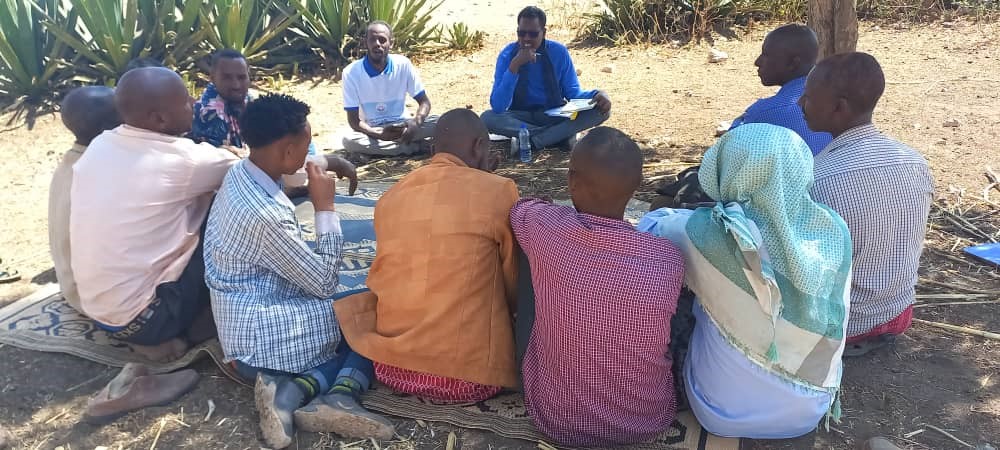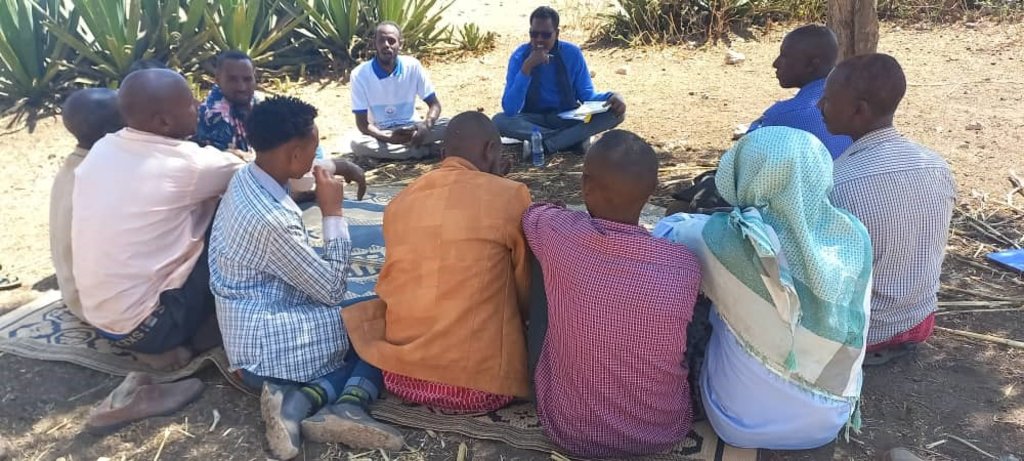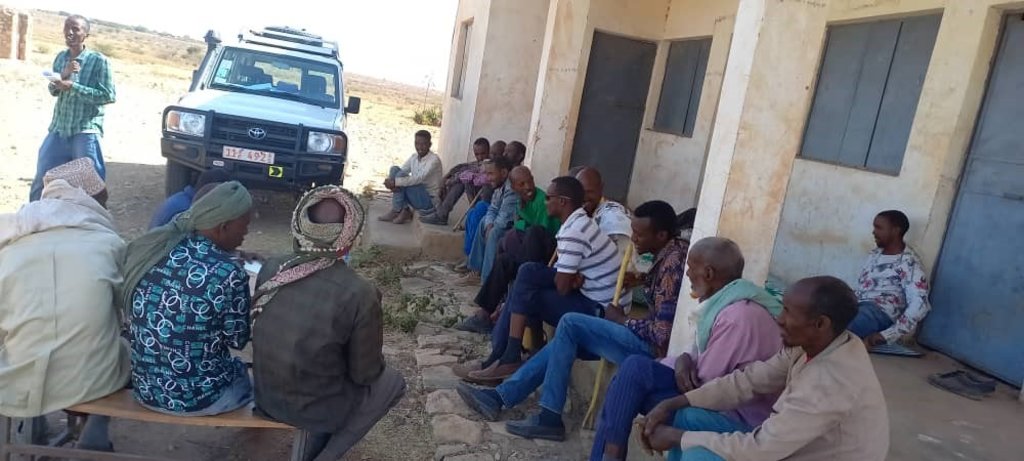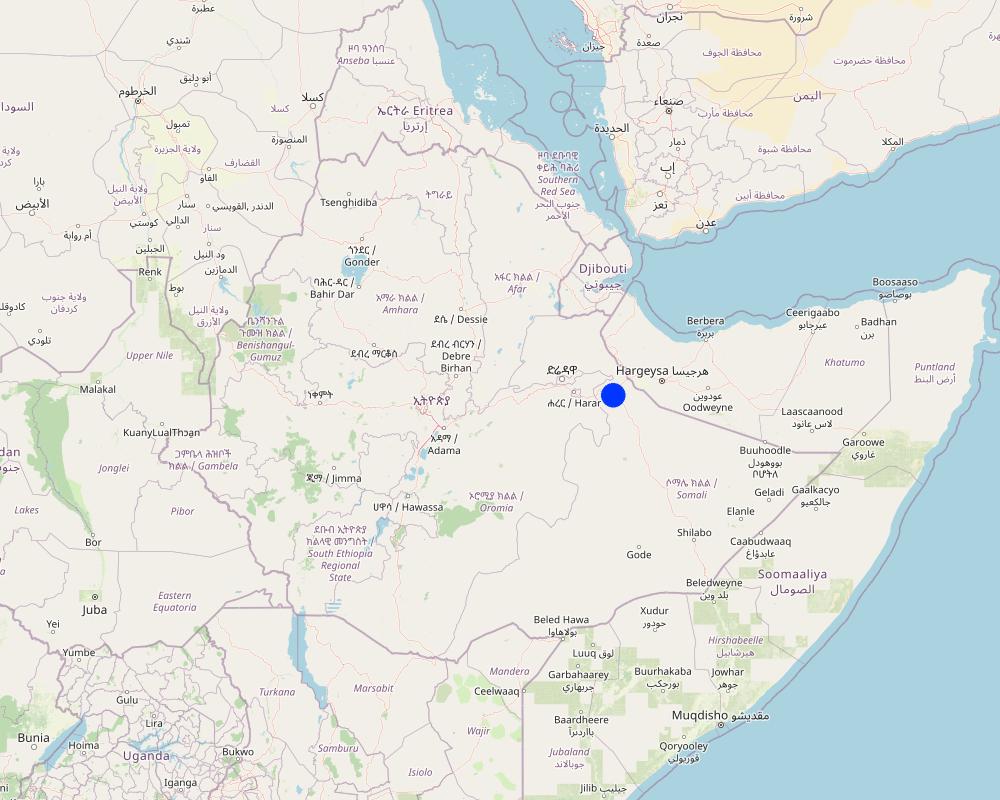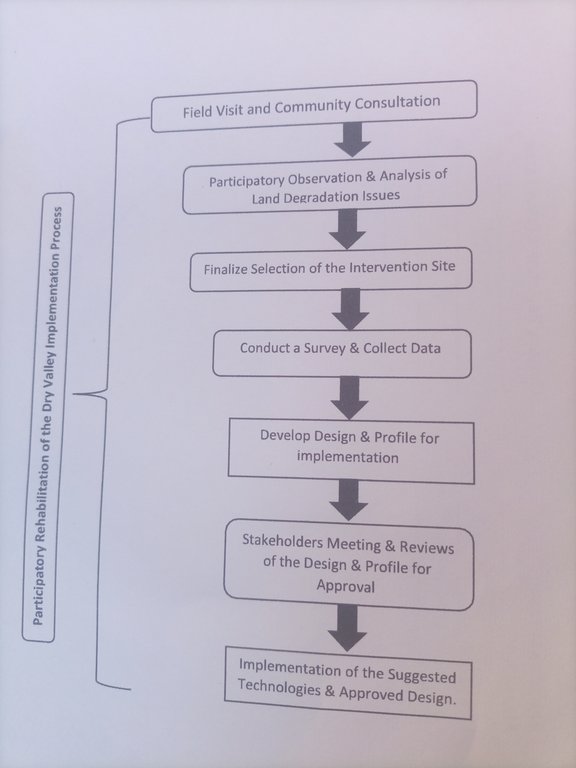Participatory Rehabilitation of Dry Valleys [Эфиопия]
- Создание:
- Обновить:
- Составитель: GERBA LETA
- Редакторы: Torben Helbig, Noel Templer, Tabitha Nekesa, Ahmadou Gaye, Siagbé Golli
- Рецензенты: William Critchley, Rima Mekdaschi Studer, Sally Bunning
Kaqayb Galka Dadwayne
approaches_6718 - Эфиопия
Просмотреть разделы
Развернуть все Свернуть все1. Общая информация
1.2 Контактные данные специалистов и организаций, участвующих в описании и оценке Подхода
Ответственный (-ые) специалист (-ы)
Специалист по УЗП:
Omer Ahmed
+251910061493
ahmdomr1954@gmail.com
Natural Resource Department of Somali Regional State Bureau of Agriculture
Somali Regional State, JigJiga
Эфиопия
Название проекта, содействовавшего документированию/оценке Подхода (если применимо)
Soil protection and rehabilitation for food security (ProSo(i)l)Название организации (-ий), содействовавших документированию/оценке Подхода (если применимо)
CIAT International Center for Tropical Agriculture (CIAT International Center for Tropical Agriculture) - Кения1.3 Условия, регламентирующие использование собранных ВОКАТ данных
Когда были собраны данные (на местах)?
22/03/2023
Составитель и ответственный/-ые специалист(-ы) согласны с условиями, регламентирующими использование собранных ВОКАТ данных:
Да
1.4 Ссылка (-и) на Анкету (-ы) по Технологиям УЗП
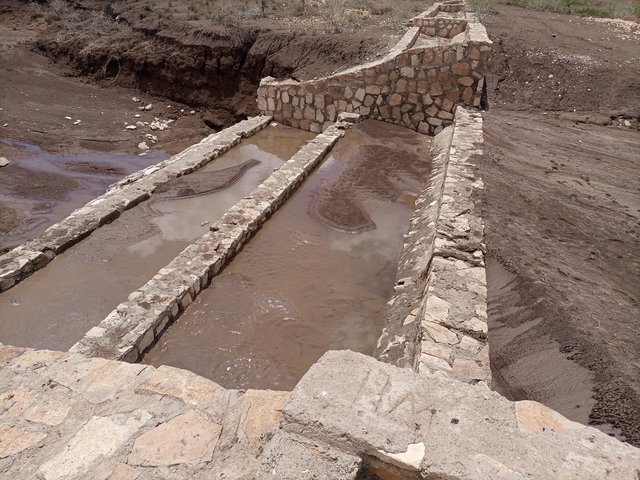
Double Basin Masonry Check Dam [Эфиопия]
A double basin masonry check dam is a physical structure that helps to stop gully formation or further development of gullies in dry valleys. It rehabilitates small to a medium-sized deep gullies that are eating into the heart of adjacent land.
- Составитель: GERBA LETA
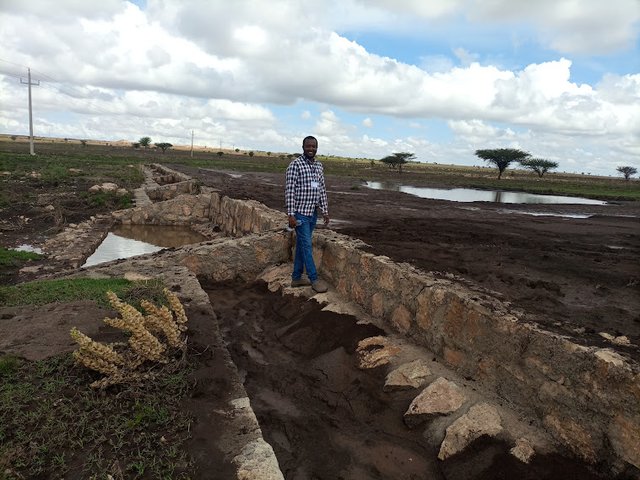
Water Spreading Weirs [Эфиопия]
Water Spreading Weirs are designed to protect the degradation of agricultural fields and rangelands. They contribute to soil and water conservation and enhance the productive use of dry valleys for food crops and livestock fodder production via the harvest and spread of runoff water and fertile soils.
- Составитель: GERBA LETA
2. Описание Подхода УЗП
2.1 Краткое описание Подхода
Participatory rehabilitation and productive use of dry valleys is an approach employed to rehabilitate degraded and degradable land. It is operationalised through the Lowland Soil Rehabilitation Project with local development partners from kebele, district, regional agricultural bureaus, and other relevant stakeholders.
2.2 Подробное описание Подхода
Подробное описание Подхода:
Participatory rehabilitation of degraded and degradable dry valleys engages the community at the grassroots through consultation. It is operationalised through the Lowland Soil Rehabilitation Project with local development partners from kebele, district, regional agricultural bureaus, and other relevant stakeholders.
Technical experts from the district and region are involved in reconnaissance, observation and joint selection of the intervention sites. The team conduct a survey, then profile and design the technologies required, along with the project engineer. The approach optimises the participation of the community and agricultural actors, allowing the development of a sense of ownership and accountability through training and awareness-creation exercises. In turn this encourages them to take care of and maintain the structures.
This approach combines top-down and bottom-up methods. At the grassroots, the local agropastoral communities are mobilized by local extension agents and made aware about the SLM intervention that the project and partners strive to put in place – including the physical structures in the farmers' fields and communal lands. The procedures include a site visit, a survey/ observation, and the identification of the intervention site based on the specific topographic features and drainage system of the catchment. Then, detailed field data is collected and a profile analysis is made to develop the design and get approval after stakeholders’ consultation and review of the details of the implementation design. The approach is complemented by satellite imagery and ground truthing. Following this, the next stage is identification of masonry experts, provision of training, and supply of construction materials and tools. Building the masonry works involves both skilled and unskilled labour.
The woreda NRM expert (focal person) facilitate the process at the grassroots through the development agents. The community gives their consent and support to the objectives of the project implementation. Therefore, they are involved in local decision-making and overseeing the technology that is being put in place.
The agropastoral community is the end user and benefits from the positive consequences of the intervention which is a result of better management of soil and water for productive uses of the dry valley. However, because of a lack of awareness, and the agropastoralists conventional livelihoods practice traveling with their livestock, there is a lack of participation in the day-to-day implementation activities. That limits their active contribution in implementation. Of course, local elders value the consultative experience which confirms a sense of self-worth and acknowledges their role in ownership of the land and as the ultimate decision-maker for development intervention operating in their areas.
2.3 Фотографии, иллюстрирующие Подход
Общие замечания к фотографиям:
Photos (undated) obtained from project staff of community engagement taking place at the beginning of the project implementation.
2.4 Видеоматериалы по применению Подхода
Комментарий, краткое описание:
Video of the approach was not documented.
2.5 Страна/ регион/ место, где применялся Подход
Страна:
Эфиопия
Административная единица (Район/Область):
Somali
Более точная привязка места:
Amadle kebele, South Jijiga district
Map
×2.6 Даты начала и окончания реализации Подхода
Год начала реализации:
2021
Комментарии:
The project termination date is not indicated.
2.7 Тип Подхода
- в рамках проекта/ программы
2.8 Каковы цели/ задачи Подхода
To engage the community and other stakeholders in making participatory decisions on the rehabilitation of the dry valley.
2.9 Условия содействующие применению Технологии/ Технологий в рамках Подхода или затрудняющие его
Наличие/ доступность финансовых ресурсов и услуг
- содействуют
Access to finance promotes intensive awareness creation and participation of the community to implement the technology at a larger scale. Also, it allows supporting the maintenance and other follow on actions that ensure sustainability.
Институциональные условия
- содействуют
Setting up the local institution such as an agropastoralist group enables the effective implementation of dry valley rehabilitation technologies/practices.
Сотрудничество/ координация действий
- содействуют
Coordination of actors enables the identification of useful actors and cross-fertilize experiential knowledge for documentation and further uses. Also, it enables acknowledgment of the contribution of different actors.
Осведомленность в области УЗП, доступность технической поддержки
- содействуют
Having SLM knowledge enables efficient and effective implementation of dry valley rehabilitation technologies.
Объем работ, доступность рабочей силы
- содействуют
Labour in the agropastoralist area is the limiting factor for the effective implementation of SLM practices. Therefore, the availability of labor or manpower is pivotal for the proper implementation of the SLM.
3. Участие и распределение ролей заинтересованных сторон
3.1 Заинтересованные стороны, участвующие в реализации Подхода и их роли
- местные землепользователи/ местные сообщества
Agropastoralist.
Participatory planning and decision making, sources casual laborer and oversee the technologies/practices.
- эксперты по УЗП/ сельскому хозяйству
Natural Resource Management experts.
Facilitate stakeholders' participation, provide technical support, and backstopping services, and monitor the development during and after the implementation of the technologies.
- частный сектор
Contractor to perform the engineering works.
Building/constructing the physical structures.
- GIZ project
GIZ (bilateral cooperation) projects.
Provide financial and technical support to the government partner organizations to promote the proper implementation of the rehabilitation of dry valley.
3.2 Участие местных землепользователей/ местных сообществ на разных стадиях реализации Подхода
| Участие местных землепользователей/ местных сообществ | Перечислите участников и опишите их вовлеченность | |
|---|---|---|
| инициирование/ мотивация | интерактивное | Agropastoralists involve in allowing peers to understand SLM-related intervention. |
| планирование | интерактивное | Land users involve in participatory planning and decision-making exercise. |
| выполнение | внешняя поддержка | Skilled and unskilled laborers are sources from neighboring urban areas and the intervention kebeles. |
| мониторинг/ оценка | внешняя поддержка | SLM experts and extension agents support in monitoring and evaluation of the intervention activities. |
3.3 Схема реализации (если имеется)
Описание:
The sketch describe the process of implementing Participatory Rehabilitation of Dry Valleys.
Автор:
Gerba Leta
3.4 Принятие решений по выбору Технологии/ Технологий УЗП
Укажите, кто принимал решение по выбору применяемой Технологии/ Технологий:
- преимущественно специалисты по УЗП после консультаций с землепользователями
Поясните:
The communities are consulted, however, selection decision is made by the SLM experts of the partner organizations in consultation with the project SLM specialists.
Поясните на чём было основано принятие решений:
- анализ подробно описанного опыта и знаний по УЗП (принятие решений на основе подтвержденных фактов)
4. Техническая поддержка, повышение компетенций и управление знаниями
4.1 Повышение компетенций/ обучение
Проводилось ли обучение землепользователей/ других заинтересованных лиц?
Да
Укажите, кто проходил обучение:
- местный персонал/консультанты
Тип обучения:
- в ходе работы
- общие собрания
Тип обучения:
- Masonry workers
Рассматриваемые темы:
Dry Land Rehabilitation and Produce Use of the rehabilitated land. Basically, the training is on the SLM practices which are suitable for agropastoralist areas with special emphasis on the physical structure.
Комментарии:
SLM experts from partner organizations and masonry workers were trained to assist in the implementation of SLM practices for dry land rehabilitation.
4.2 Консультационные услуги
Есть ли у землепользователей возможность получать консультации?
Да
Укажите, где именно оказываются консультационные услуги:
- на полях землепользователей
Описание/ комментарий:
Advisory services related to SLM are infrequently given. As the agropastoralists are mobile looking for feed and water, particularly during the dry period, advisory services have not been provided on regular basis.
4.3 Институциональная (организационная) поддержка
В ходе реализации Подхода были ли организованы новые институциональные структуры или поддержаны уже существующие?
- да, немного
Укажите уровень, на котором структуры были укреплены или вновь созданы:
- местные
Опишите организацию, функции и ответственность, членство и т.д.
Stakeholders from government and bilateral organization (project) do make ad hoc meeting during planning and evaluation, this brings actors together but need to establish a sustainable institution that stands on its own and can be working beyond the project's lifetime. Particularly, a land users (agropastoralist) group is essential to oversee the technology placed on their land so that sustainability of the intervention can be ensured.
Укажите тип поддержки:
- финансовая
- повышение компетенций/ обучение
- оборудование
Подробнее:
The equipment refers to the technical tools that can be used by the partner experts - but not farm tools. The latter is expected during which the agropastoralist resumes the productive use of the rehabilitated land which is currently in the initial years of implementation and not yet associated with the productive uses of it.
4.4 Мониторинг и оценка
Являются ли мониторинг и оценка частью Подхода?
Да
Комментарии:
The monitoring and evaluation are part of the project implementation that enables the implementers to track the development and engage the end users to enable them to sense the benefits. The land users started to benefit from the structure such as fetching drinking water both for human and their livestock, though, it is an indirect benefit from the intervention.
Если да, будет ли данный документ использоваться для мониторинга и оценки?
Да
4.5 Научные исследования
Были ли научные исследования частью Подхода?
Нет
5. Финансирование и внешняя материальная поддержка
5.1 Годовой бюджет мероприятий по УЗП в рамках Подхода
Если точный годовой бюжет неизвестен, укажите примерный диапазон затрат:
- 2000-10000
Комментарий (например, основные источники финансирования/ ключевые доноры):
No specific data on budget allocation for SLM at the district level. However, Local Subsidy Contract (LSC) was used to assist the woreda implement and follow-up the development of the intervention.
5.2 Финансирование и внешняя материальная поддержка, предоставляемая землепользователям
Предоставлялась ли землепользователям финансовая/ материальная поддержка для применения Технологии /Технологий?
Нет
5.3 Субсидии на отдельные затраты (включая оплату труда)
Комментарии:
There is no subsidy system supplied to the land users. Labor contribution is on a pay basis in cash. As the area is characterized by food insecurity and drought-prone by virtue, free labor is not expected. Basically, skilled and unskilled labor imported from the nearby town. Thus, it is impossible to assign this role to the land users.
5.4 Кредитование
Предоставлялись ли в рамках Подхода кредиты на мероприятия УЗП?
Нет
5.5 Другие методы или инструменты стимулирования
Использовались ли другие методы или инструменты стимулирования для продвижения Технологий УЗП?
Нет
6. Анализ влияния и заключительные положения
6.1 Влияние Подхода
Сумел ли Подход расширить возможности местных землепользователей, повысить участие заинтересованных сторон?
- Нет
- Да, немного
- Да, умеренно
- Да, существенно
Local land users consulted and informed regarding the benefits of SLM for the degraded and potentially degradable lands to ensure rehabilitation and its productive use. This may give motivation and a sense of self-worth as land owner.
Сумел ли Подход дать возможность принимать решения на основе подтвержденных фактов?
- Нет
- Да, немного
- Да, умеренно
- Да, существенно
Beyond the approach, the land users can learn from the actual function of the technologies.
Сумел ли Подход помочь землепользователям внедрить и поддерживать технологии УЗП?
- Нет
- Да, немного
- Да, умеренно
- Да, существенно
Consultation with the land users motivates them to build trust in the intervention.
Сумел ли Подход улучшить согласованность действий и повысить рентабельность применения практик УЗП:
- Нет
- Да, немного
- Да, умеренно
- Да, существенно
In the long run, it can assist land users mobilize casual laborers.
Сумел ли Подход мобилизовать/ расширить доступ к финансовым ресурсам для применения практик УЗП?
- Нет
- Да, немного
- Да, умеренно
- Да, существенно
Сумел ли Подход расширить знания и возможности землепользователей в применении практик УЗП?
- Нет
- Да, немного
- Да, умеренно
- Да, существенно
The approach creates an opportunity for land users to engage in the initial implementation process through which their awareness is raised.
Сумел ли Подход расширить знания и возможности других заинтересованных сторон?
- Нет
- Да, немного
- Да, умеренно
- Да, существенно
Through stakeholders meeting and training opportunities created by the project.
Сумел ли Подход укрепить сотрудничество между заинтересоваными сторонами/ выстроить механизмы сотрудничества?
- Нет
- Да, немного
- Да, умеренно
- Да, существенно
It builds collaboration between stakeholders.
Сумел ли Подход снизить остроту конфликтов?
- Нет
- Да, немного
- Да, умеренно
- Да, существенно
Сумел ли Подход расширить возможности социально и экономически уязвимых групп?
- Нет
- Да, немного
- Да, умеренно
- Да, существенно
Involve them in the awareness creation training.
Сумел ли Подход содействать гендерному равенству и расширить права и возможности женщин и девочек?
- Нет
- Да, немного
- Да, умеренно
- Да, существенно
Women are involved in the community meeting and/or consultation. Also benefited from the technology as it creates the opportunity to fetch drinking still water closer to their residence.
Сумел ли Подход стимулировать молодежь/ будущее поколение землепользователей заниматься УЗП?
- Нет
- Да, немного
- Да, умеренно
- Да, существенно
It provides knowledge to the young generation through exposure to evidence based intervention.
Сумел ли Подход разрешить правовые проблемы землевладения/ землепользования, препятствующие использованию технологий УЗП?
- Нет
- Да, немного
- Да, умеренно
- Да, существенно
Сумел ли Подход способствовать улучшению продовольственой безопасности/ качества питания?
- Нет
- Да, немного
- Да, умеренно
- Да, существенно
The technology implemented using the participatory approach believed to rehabilitate degraded lands and enhances productive use of the rehabilitated lands for growing various crops, and supply feeds to the livestock.
Сумел ли Подход расширить доступ к рынкам?
- Нет
- Да, немного
- Да, умеренно
- Да, существенно
Сумел ли Подход улучшить санитарные условия и доступ к водоснабжению?
- Нет
- Да, немного
- Да, умеренно
- Да, существенно
The technology implemented using this approach creates land users temporal access to still as well as groundwater regardless.
Сумел ли Подход привести к более эффективному использованию электроэнергии/ возобновляемых источников энергии?
- Нет
- Да, немного
- Да, умеренно
- Да, существенно
Сумел ли Подход улучшить способность землепользователей адаптироваться к изменениям климата и смягчать последствия катастрофических погодных явлений?
- Нет
- Да, немного
- Да, умеренно
- Да, существенно
In the future, when the productive use of dry valley is effected, post the rehabilitation efforts, land users certainly develop an adaptation to climate change and associated disasters through participatory approach.
Сумел ли Подход привести к созданию новых рабочих мест/ к расширению возможностей получения дохода?
- Нет
- Да, немного
- Да, умеренно
- Да, существенно
It improves generation of income from the production of food and feed crops.
6.2 Основные причины, побуждающие землепользователей внедрять УЗП
- рост продуктивности
Food crops and livestock feed production are increased as the technology reduces the intensity and effects of erosion and conserves soil and water.
- рост прибыли (доходности) и рентабельности
Over time, the technology/approach improves the productive use of rehabilitated land for crop and livestock production that increases overall benefits.
- снижение деградации земель
As the structure stops heavy movement of the soil with runoff, it absolutely reduces the rate or speed of erosion and land degradation.
- снижение риска катастрофических погодных явлений
The water harvested and spread on the farmland reduces the risks of crop failure and can be used for spate irrigation. Furthermore, the structure reduces the speed of runoff and retain the top soil moving away.
- приобретение знаний и опыта в области УЗП
The exposure to training and collective action and lesson learnt from the outcome of the implementation enhance knowledge and skills of the land users and experts.
6.3 Долгосрочная устойчивость мероприятий в рамках Подхода
Могут ли землепользователи самостоятельно (без внешней поддержки) продолжать применение того, что было реализовано в рамках Подхода?
- нет уверенности
Если нет или нет уверенности, объясните почему:
As maintenance of the structure such as in cases of check dam is resource demanding, it is less likely for the land users to maintain/repair on their own. Rather early combining the physical structure by biological barriers or perennial forage or tree planation may ensure sustainability of the technology/land use. Furthermore, it demands time and labor from the agro-pastoralists.
6.4 Сильные стороны/ преимущества Подхода
| Сильные стороны/ преимущества/ возможности по мнению землепользователей |
|---|
| Creates stakeholders awareness on SLM, and productive use of rehabilitated dry valley. |
| Improves coordination between agricultural actors in line offices, and other stakeholders collective action. |
| Enhances participatory decision making on the development and use of the rehabilitated lands. |
| Сильные стороны/ преимущества/ возможности по мнению составителя или других ключевых специалистов |
|---|
| It creates evidence based lesson learning to replicate similar practices across the region. |
| It improves SLM implementation capacity of the development partners (agricultural offices) and the land users at local level. |
| It encourages the government respective department to allocate matching fund for SLM operationalized by development partners. |
6.5 Слабые стороны/ недостатки Подхода и пути их преодоления
| Слабые стороны/ недостатки/ риски по мнению землепользователей | Возможные пути их преодоления/снижения? |
|---|---|
| Time and energy/labor demanding to integrate efforts of experts from different organizations. | Nurture proper joint planning for collective action. |
| Shortage of financial and material resources to put the structure in place. | Find and generate sources of resources and promote efficient use of the available budget. |
| Improper participation of stakeholders (dropout of experts) | Enforce participation through adopting binding by-laws to all. |
| Слабые стороны/ недостатки/ риски по мнению составителя или ответственных специалистов | Возможные пути их преодоления/снижения? |
|---|---|
| Recurrent droughts displace the land users while looking for water and feed to their animals. | Ensure representation to the community, and assess enabling environment that reduce temporal displacement of the land users. |
| Relatively low participation of the land users in the conception and implementation of the approach as well as the technology intended to rehabilitate the dry valley. | Promote land users participation through intensive capacity building and awareness creation by gender and various categories of the community. |
| Lack of forming agro-pastoralist group who are believed to share knowledge, skills and labor for collective oversee and maintenance of the technology when damage is encountered. | Promote the development of a local institution that allows not only for the use of the land but also to oversee the gaps, report the issues, and involve in participatory fixing activities. |
7. Справочные материалы и ссылки
7.1 Методы сбора/источники информации
- выезды на места, полевые обследования
Three individuals
- опросы специалистов/экспертов по УЗП
Four
7.2 Ссылки на опубликованные материалы
Название, автор, год публикации, ISBN:
Problems and landscape approach for ecological rehabilitation in the dry valleys of Southwest China. Dong, Y. & Liu, S. (Undated)
Где опубликовано? Стоимость?
https://www.researchgate.net/profile/Shiliang-Liu-5/publication/221354340_Problems_and_Landscape_Approach_for_Ecological_Rehabilitation_in_the_Dry_Valleys_of_Southwest_China/links/574129be08ae9ace84160bec/
7.3 Ссылки на материалы, доступные онлайн
Название/ описание:
Supporting local planning and the importance of mapping
Адрес в сети Интернет:
https://dream.vandermeijde.net/wp-content/uploads/2022/11/220620_planningandmapping_Roden.pdf
Ссылки и модули
Развернуть все Свернуть всеСсылки

Double Basin Masonry Check Dam [Эфиопия]
A double basin masonry check dam is a physical structure that helps to stop gully formation or further development of gullies in dry valleys. It rehabilitates small to a medium-sized deep gullies that are eating into the heart of adjacent land.
- Составитель: GERBA LETA

Water Spreading Weirs [Эфиопия]
Water Spreading Weirs are designed to protect the degradation of agricultural fields and rangelands. They contribute to soil and water conservation and enhance the productive use of dry valleys for food crops and livestock fodder production via the harvest and spread of runoff water and fertile soils.
- Составитель: GERBA LETA
Модули
Нет модулей


